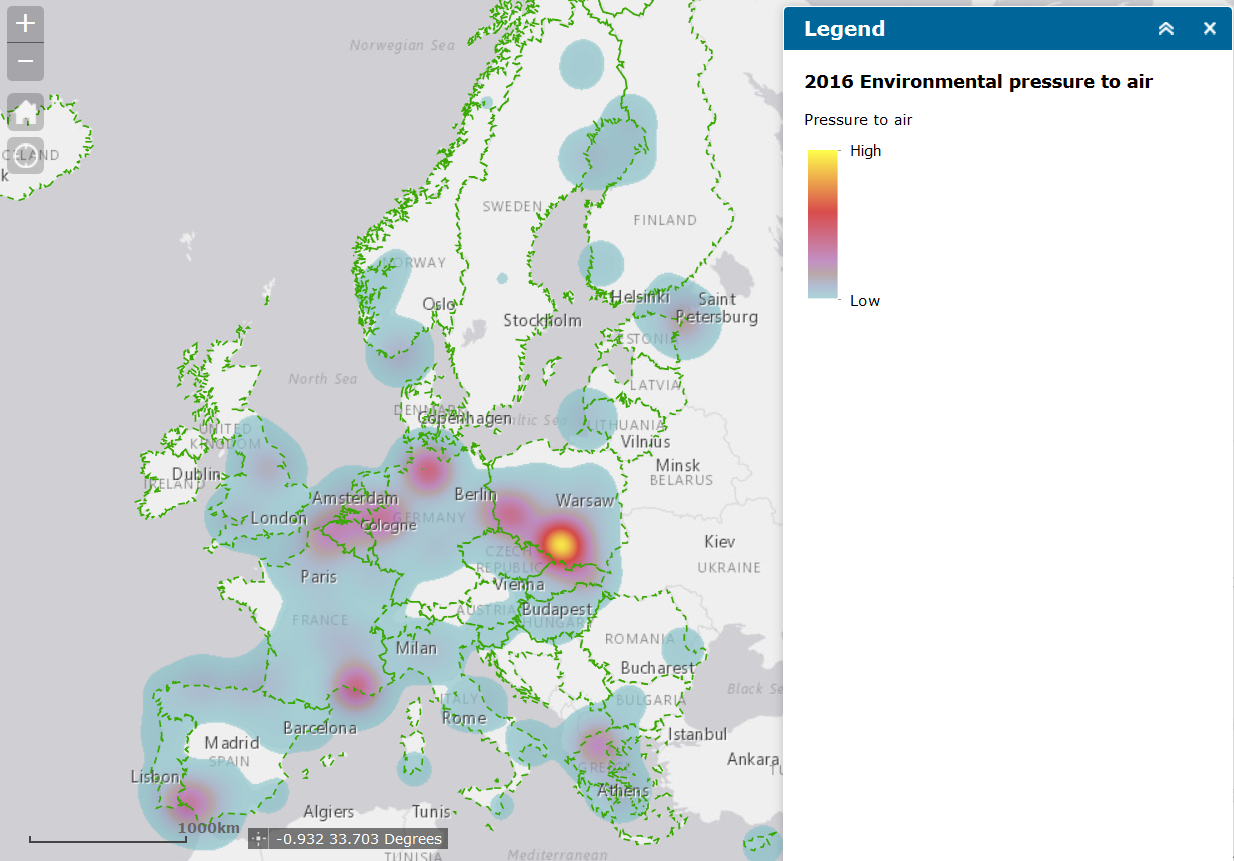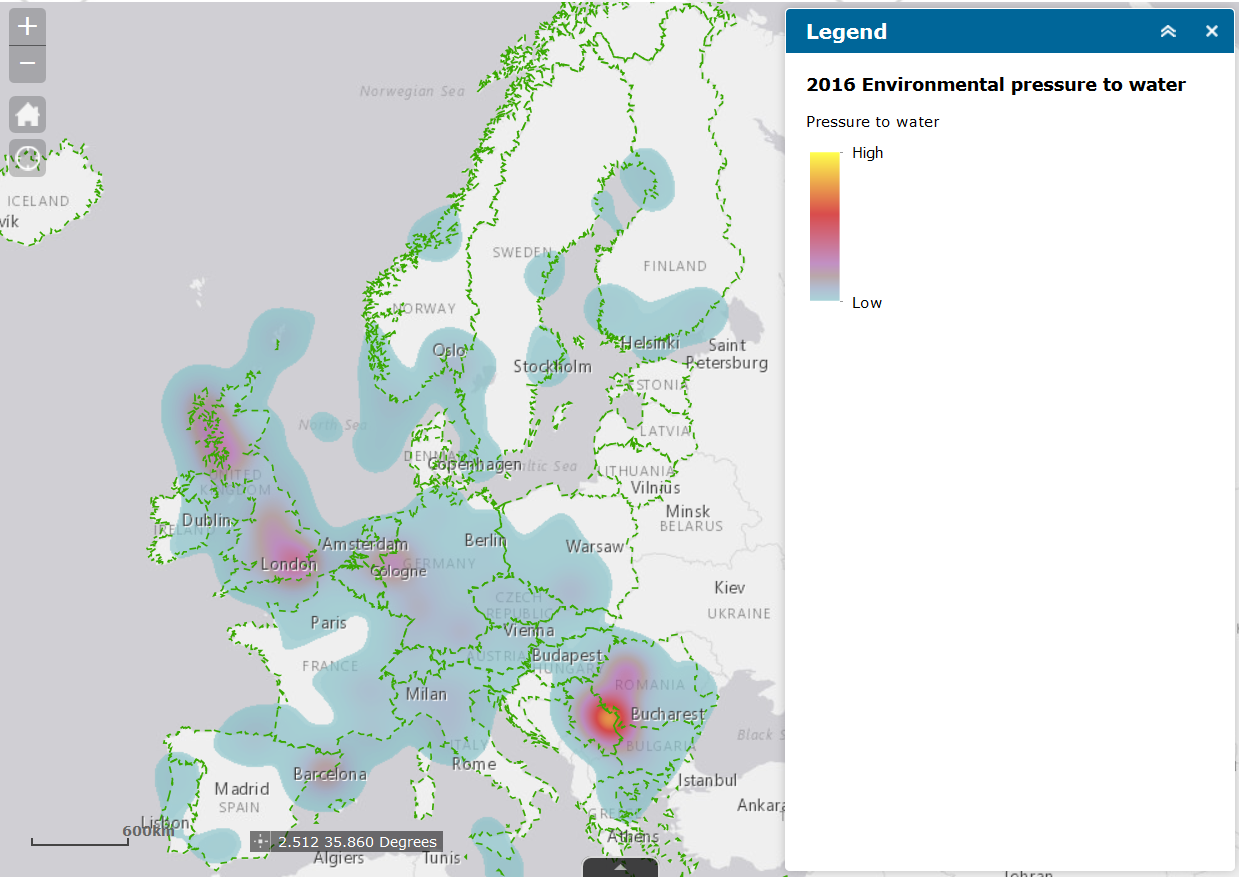This briefing focuses on reported releases to air and water of the following heavy metals: arsenic (As), cadmium (Cd), chromium (Cr), copper (Cu), lead (Pb), mercury (Hg), nickel (Ni) and zinc (Zn). Heavy metals are released by a range of industrial and other sources, but may also occur naturally in the environment. They can cause harmful effects in plants, animals and humans as a result of long-term or frequent exposure to high concentrations in air, water or soil. Such effects can range from the disruption of nutrient cycling in plants to effects on growth and reproduction in plants, animals and humans (see E-PRTR pollutant descriptions for more information). The EEA indicator Heavy metal emissions provides additional insights on emissions to air from Europe’s industrial facilities.
The USEtox model
To estimate the overall pressures on the environment from the aggregated releases of the eight heavy metals in this briefing, values (in kilograms) of the individual releases are first multiplied by a respective ‘eco-toxicity factor’, sourced from the USEtox model. Results are then aggregated, first by facility and then illustrated spatially using a standard heat map tool in the ESRI ArcGIS software.
The USEtox model was developed in cooperation with the United Nations Environment Programme and has been recommended by the European Commission as a source of information on environmental foot-printing. The same approach has also been applied to E-PRTR data at a national scale e.g. in Sweden (Nordborg et al, 2017). It is important to note that the mapped emissions do not provide information on the distribution or concentrations of heavy metals in the environment. Rather, the maps are a geographical representation of the locations of source facilities responsible for the most harmful (to ecosystems) aggregated releases of heavy metals.
How are sources of heavy metal releases to air distributed across Europe?

For eco-toxicity weighted aggregated releases to air, the resulting pressure on the environment is greatest from sources where either large-scale individual metal processing sites, power plants or clusters of facilities with relatively small individual releases are located. Prominent examples of such facilities can be seen on the map (Figure 1), including:
- AcelorMittal Poland in Dąbrowa Górnicza near Katowice, Poland (metal ore processing);
- Atlantic Copper, S.L.U. in Huelva, Spain (non-ferrous metal production);
- a cluster of facilities in Lünen near Dortmund, Germany (four power plants, and a metal production and processing facility);
- Norddeutsche Affinerie AG in Hamburg, Germany (non-ferrous metal production);
- a cluster of facilities around Glogow, Poland (multiple metal production and processing sites as well as underground mines); and
- Agios Dimitrios power plant near Ptolemaida, Greece.
Of the 978 facilities releasing heavy metals to air in 2016, just 18 were responsible for more than half of the associated environmental pressure, as estimated using the aggregated eco-toxicity approach. Since 2010, the total pressure because of heavy metal releases to air has decreased by 39 % and significantly fewer facilities have reported these substances than in previous years.
Applying the USEtox method to E-PRTR data further reveals (Figure 2) that metal production and processing combined were responsible for 59 % of environmental pressure in 2016. Heavy metals tend to be present in the combustion gases released from the heating/melting processes associated with these activities.
Thermal power stations were responsible for another 20 % of environmental pressure in 2016. Other contributing activities are underground mining operations, oil and gas refineries, and glass manufacturing and chemical production facilities.
How are sources of heavy metal releases to water distributed across Europe?

A total of 2 585 facilities reported heavy metal releases to water bodies across Europe in 2016. The associated environmental pressure has decreased by 34 % since 2010, while the number of facilities reporting releases has increased by 5 %.
The following activities release heavy metals directly to water:
- Mining activities, which accounted for 19 % of environmental pressure in 2016 (Figure 4). The Bor mine in Serbia was the largest contributor.
- Intensive aquaculture (14 % of pressure), for example in Scotland and the coast of Norway. Both copper and zinc are used to treat fish nets and cages, preventing corrosion and the growth of barnacles and other organisms on them.
- The energy supply sector (6 % of pressure), including oil and gas exploration in the North Sea as well as individual power plants.
After years of effort and investment in urban waste water treatment infrastructure in Europe (see the EEA indicator ‘Urban wastewater treatment’), many industries now rely on urban waste water treatment plants to purify water effluent. However, remediating heavy metals in urban waste water is not the main focus of such plants. As a result, waste water treatment plants appear to have been responsible for almost half of the environmental pressure in 2016. However, these plants merely concentrate the pollution originating from facilities in the surrounding area (see Figure 3).
As a result, the following areas feature on the map (Figure 3):
- the London metropolitan area, UK, where urban waste water treatment plants are influenced by landfill and hazardous waste treatment sites, metal processing facilities and chemical production among others;
- Duisburg, Germany, where one treatment plant in particular is influenced by two iron and steel production sites and a coke oven operation;
- Barcelona, Spain, where metal processing, and chemical and food processing influence a number of waste water treatment plants.
What is Europe doing to reduce releases of heavy metals?
Europe is actively addressing the issue of heavy metal releases to the environment. The Industrial Emission Directive (2010/75/EU or IED) is the EU’s main legislation on environmental pollution — including heavy metals — from industrial and other large point source activities. The directive entered into force in early 2011 and adopts an integrated view by considering emissions to all media (air, water and land) as well as waste generated and energy efficiency.
The EU is also party to the Convention on Long-range Transboundary Air Pollution 1998 Protocol on Heavy Metals, which targets three particularly harmful substances: Cd, Hg and Pb. More recently, the Minamata Convention on Mercury — a global, legally binding treaty — was agreed by governments in January 2013 and formally adopted as international law on 10 October 2013. In response, the EU has recently put in place the Mercury Regulation (2017/852/EU).
The Water Framework Directive (2000/60/EC) establishes a requirement to achieve good ecological and chemical status in European waters. This includes targets for the reduction of heavy metal concentrations.
About the E-PRTR
The E-PRTR covers approximately 33 000 facilities over 65 economic activities and is available for the EU-28 Member States, the EFTA countries (Iceland, Liechtenstein, Norway and Switzerland) and Serbia. These countries recently reported official data for 2016 to the E-PRTR.
The updated E-PRTR data show, for each facility, information concerning the amounts of pollutants released in 2016 to air, water and land, as well as off-site transfers of waste and pollutants in waste water.
Document Actions
Share with others